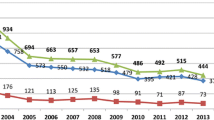Abstract
Women undergoing cardiac catheterization have an increased risk of vascular complications (VC) compared to men. Whether this is due to gender differences in common femoral artery (CFA) anatomy remains unknown. Therefore, we examined angiographic features of CFA to identify differences in predictors of VC between the genders. A case control study design enrolled 59 (30 women and 29 men) consecutive patients with VC and 59 age, gender and procedure matched controls from 2004 to 2009. VC were defined as hematoma >6 cm, any access site related bleeding requiring transfusion or injury requiring mechanical intervention. Quantitative angiography was performed on all femoral angiograms. Univariate and multivariate regression was performed to define clinical and angiographic predictors of VC. Among all patients, cases had significantly lower BMI than controls (28.4 ± 7.7 vs. 32.0 ± 6.7, p ≤ 0.01) and were more than twice likely to have CFA reference vessel diameter <5.5 mm (p = 0.04). This finding was entirely driven by the inverse relationship between BMI, CFA and VC among women. On multivariate analysis, BMI was a potent predictor of VC (OR 0.94; 95 % CI 0.89–0.99; p = 0.04). When comparing men and women, BMI and CFA size were predictors of VC among women only. Among men, site of arteriotomy and diabetes mellitus predicted risk of VC. Smaller BMI correlates with smaller CFA diameter and both are predictive of increased risk of VC. This may explain the female predisposition to VC. Risk stratification for bleeding and VC should address these gender specific findings.



Similar content being viewed by others
References
Ndrepepa G, Berger PB, Mehilli J, Seyfarth M, Neumann FJ, Schomig A (2008) Periprocedural bleeding and 1-year outcome after percutaneous coronary interventions: appropriateness of including bleeding as a component of a quadruple end point. J Am Coll Cardiol 51(7):690–697
Manoukian SV, Feit F, Mehran R, Voeltz MD, Ebrahimi R, Hamon M (2007) Impact of major bleeding on 30-day mortality and clinical outcomes in patients with acute coronary syndromes: an analysis from the ACUITY Trial. J Am Coll Cardiol 49(12):1362–1368
Applegate R, Sacrinty M, Little W, Gandhi S, Kutcher M, Santos R (2009) Prognostic implications of vascular complications following PCI. Cathet Cardiovasc Interv 74(1):64–73
Applegate RJ, Sacrinty MT, Kutcher MA, Kahl FR, Gandhi SK, Santos RM (2008) Trends in vascular complications after diagnostic cardiac catheterization and percutaneous coronary intervention via the femoral artery, 1998 to 2007. JACC Cardiovasc Interv 1(3):317–326
Dauerman HL, Applegate RJ, Cohen DJ (2007) Vascular closure devices: the second decade. J Am Coll Cardiol 50(17):1617–1626
Tavris DR, Gallauresi BA, Dey S, Brindis R, Mitchel K (2007) Risk of local adverse events by gender following cardiac catheterization. Pharmacoepidemiol Drug Saf 16(2):125–131
Tavris DR, Dey S, Brecht-Gallauresi B, Brindis RG, Shaw R, Weintraub W (2005) Risk of local adverse events following cardiac catheterization by hemostasis device use—phase II. J Invasive Cardiol 17(12):644–650
Ahmed B, Piper WD, Malenka D, Verlee P, Robb J, Tl Ryan (2009) Significantly improved vascular complications among women undergoing percutaneous coronary intervention: a report from the Northern New England percutaneous coronary intervention registry. Circ Cardiovasc Interv 2(5):423–429
Konstance R, Tcheng JE, Wightman MB, Kelly LP, Moore A, Harrison JK (2004) Incidence and predictors of major vascular complications after percutaneous coronary intervention in the glycoprotein IIb/IIIa platelet inhibitor era. J Interv Cardiol 17(2):65–70
Sherev DA, Shaw RE, Brent BN (2005) Angiographic predictors of femoral access site complications: implication for planned percutaneous coronary intervention. Catheter Cardiovasc Interv 65(2):196–202 13
Applegate RJ, Sacrinty MT, Kutcher MA, Baki TT, Gandhi SK, Santos RM (2006) Propensity score analysis of vascular complications after diagnostic cardiac catheterization and percutaneous coronary intervention 1998–2003. Catheter Cardiovasc Interv 67(4):556–562
Schnyder G, Sawhney N, Whisenant B, Tsimikas S, Turi ZG (2001) Common femoral artery anatomy is influenced by demographics and comorbidity: implications for cardiac and peripheral invasive studies. Catheter Cardiovasc Interv 53(3):289–295
Ahmed B, Lischke S, Holterman LA, Straight F, Dauerman HL (2010) Angiographic predictors of vascular complications among women undergoing cardiac catheterization and intervention. J Invasive Cardiol 22(11):512–516
Bonello L, Bonello-Palot N, Armero S, Bonello C, Mokhtar OA, Arques S (2010) Impact of P2Y12-ADP receptor polymorphism on the efficacy of clopidogrel dose-adjustment according to platelet reactivity monitoring in coronary artery disease patients. Thromb Res 125(4):e167–e170
Barker CM, Murray SS, Teirstein PS, Kandzari DE, Topol EJ, Price MJ (2010) Pilot study of the antiplatelet effect of increased clopidogrel maintenance dosing and its relationship to CYP2C19 genotype in patients with high on-treatment reactivity. J Am Coll Cardiol Intv 3(10):1001–1007
Author information
Authors and Affiliations
Corresponding author
Rights and permissions
About this article
Cite this article
Ahmed, B., Lischke, S., De Sarno, M. et al. Gender related differences in predictors of vascular complications: role of vessel size and BMI. J Thromb Thrombolysis 36, 84–90 (2013). https://doi.org/10.1007/s11239-012-0847-y
Published:
Issue Date:
DOI: https://doi.org/10.1007/s11239-012-0847-y




